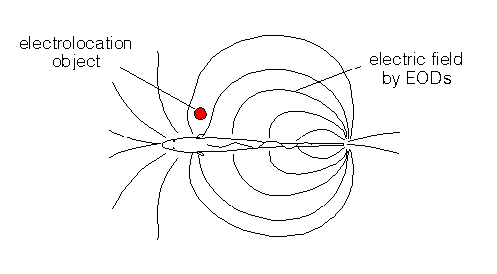Behavioral Neuroscience, lecture on electric fish
Jamming
IV. Afferent Path for Electroreception
A. Specialized receptors segregate sensory information
into amplitude and phase pathways
1. distributed over the body surface
2. Ampullary (P-) Electrosensory Receptors
a. sensitive to 10 mV/cm in freshwater
i.sensitive to DC fields
ii. sensitive to frequencies < 50 Hz
b. code modulations of EOD amplitude
i. fire with a probability of less than 1.0
for stimuli within the normal EOD intensity range
ii. firing probability changes with stimulus intensity
c. Jelly-filled canal leads to skin surface
d. Glu
2. Tuberous (T-) Electrosensory Receptors
a. 0.1 mV - 10 mV/cm
b. code modulations of EOD phase
c. fire at the rate of one spike per EOD cycle
i. phase-locked to the EOD
ii. contain information with respect to the time
of positive zero crossing in the EOD wave
3. Mormyromast A-/B-Electrosensory Receptors
a. perceive the EOD intensity & variation of the EOD waveform
i. due to the resistance-capacitance structure of the cells
b. current depolarizes the basal membrane
i. caused by EOD
c. release of Glu excites the afferent fiber
i. oscillates after a certain time interval
ii. spike latencies of the afferent fiber encode
the amplitude and/or distortion of the EOD waveform
d. A-receptors mainly respond to the EOD intensity
i. B-receptors are sensitive to the variation of EOD waveform
4. Mechanosensory Receptors
a. Lateral Line
i. also includes electrosensory receptors
5. Sensory afferent cell to ELL near cerebellum
a. AMPA/NMDA excitation
b. Glu output in ELL
B. Electrosensory Lateral Line lobe (ELL) located in medulla
1. input Glu ð AMPA/NMDA
2. separation necessary for specific behavioral responses
a. separate ouputs to dorsal amplitude (V) pathway
i. Glu
b. phase pathway
i. Glu
c. corollary discharge
i. paratrigeminal command-associated nucleus
ii. electrosensory cerebellar granule cell zone
(1) overlays the ELL
3. feedback
a. nucleus praeeminentialis (NP)
i. directly to ELL
ii. indirect via EGp
iii. NP in midbrain
b. eminentia granularis pars posterior (EGp)
i. EGp in hindbrain
C. midbrain Torus Semicircularis (TS; inferior colliculus)
1. sign-selective cells
a. converge amplitude and phase information based on specific frequencies
i. positive frequency differential (FD)
ii. negative FD
2. dorsal TS
a. electrosensory information
i. respond to jamming signals
ii. respond to moving electrosensory stimuli
b. receives convergent info from ELL
i. AMPA/NMDA
c. somatotopically organized
i. pisculus
(1) fish shaped neural representation
(2) head rostral, tail caudal
d. 2x Glu output to nucleus Electrosensorius (nE)
i. nEb
ii. nEñ
3. ventral TS
a. electrosensory and mechanosensory information
b. Glu output to nEAR = nEò
